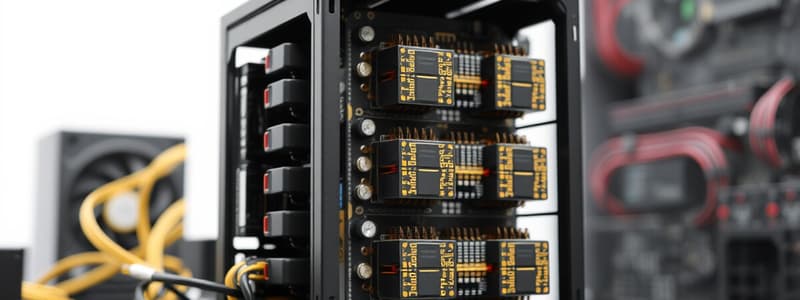Podcast
Questions and Answers
What types of operations can the ALU perform?
What types of operations can the ALU perform?
- Arithmetic and logical operations (correct)
- Only logical operations
- Only arithmetic operations
- Data storage operations
What is the role of the instruction decoder?
What is the role of the instruction decoder?
- To manage input/output operations
- To decode the contents of the instruction register (correct)
- To store micro-routines for execution
- To generate clock signals
Which component temporarily stores the results of arithmetic and logic operations?
Which component temporarily stores the results of arithmetic and logic operations?
- Flag register
- Accumulator (correct)
- Address buffer
- Instruction register
What function does the oscillator serve in the timing and control unit?
What function does the oscillator serve in the timing and control unit?
What is the purpose of the SIM and RIM instructions?
What is the purpose of the SIM and RIM instructions?
What is the primary function of the accumulator in the ALU?
What is the primary function of the accumulator in the ALU?
Which register is specifically designed to maintain the address of the last data entered into the stack?
Which register is specifically designed to maintain the address of the last data entered into the stack?
Which of the following statements is true regarding the General Purpose Registers in Intel 8085?
Which of the following statements is true regarding the General Purpose Registers in Intel 8085?
What occurs to the Program Counter (PC) after the execution of an instruction?
What occurs to the Program Counter (PC) after the execution of an instruction?
How does the Incrementer-Decrementer function in relation to the Stack Pointer or Program Counter?
How does the Incrementer-Decrementer function in relation to the Stack Pointer or Program Counter?
Flashcards are hidden until you start studying
Study Notes
Accumulator
- An 8-bit register that holds data for processing by the Arithmetic Logic Unit (ALU).
- Stores results of operations and is also referred to as the A register.
- Connected to an 8-bit internal data bus for data transfer.
Temporary Register
- Receives data from external memory or general-purpose registers for the ALU.
- Supplies one input to the ALU while the other input is from the accumulator.
- Used for storing operands in arithmetic and logic operations.
General Purpose Registers
- Six 8-bit general-purpose registers: B, C, D, E, H, and L.
- Registers can be used individually or combined as pairs (BC, DE, HL) for 16-bit operations.
- HL register pair typically serves as a 16-bit memory pointer.
Stack Pointer (SP)
- A 16-bit register that maintains the address of the last byte entered into the stack.
- Stack is a reserved area of RAM for temporary data storage.
- Decrements on data entry and increments on data retrieval.
Program Counter (PC)
- A 16-bit memory pointer that sequences instruction execution.
- Points to the address of the next instruction.
- Increments by one after executing an instruction to indicate the next location.
Incrementer-Decrementer
- Can add or subtract one from the contents of the stack pointer or program counter.
Arithmetic and Logic Unit (ALU)
- Executes arithmetic (addition, subtraction) and logic operations (AND, OR, XOR) on 8-bit data.
- Inputs to the ALU are from the accumulator and the temporary register.
- Stores results back in the accumulator.
Flags
- Composed of five individual flip-flops indicating statuses after arithmetic and logic operations.
Instruction Register and Decoder
- An 8-bit register that fetches and loads instructions from memory.
- Instruction decoder decodes contents to determine operation execution and directs the timing and control unit.
Timing and Control Unit
- Contains an oscillator generating two-phase clock signals (CLK and CLK bar) for synchronization of registers.
- The controller sequencer is micro-programmed and contains ROM for storing micro-routines needed for instruction execution.
Interrupt Control
- Manages temporary interruptions for input/output (I/O) device requests.
- The main program execution is halted to process interrupt signals for data input.
Serial I/O Control
- Manages serial data input and output for I/O devices.
- Data enters the 8085 microprocessor through SID (serial input data) and exits through SOD (serial output data).
- SIM and RIM instructions facilitate serial-parallel conversion for serial I/O operations.
Address Buffers
- Contents of the stack pointer or program counter can be loaded into address buffers.
- Outputs direct external address and address data buses, connecting memory and I/O chips to the CPU.
- Enables the CPU to send addresses for desired data to memory or I/O devices.
Studying That Suits You
Use AI to generate personalized quizzes and flashcards to suit your learning preferences.




